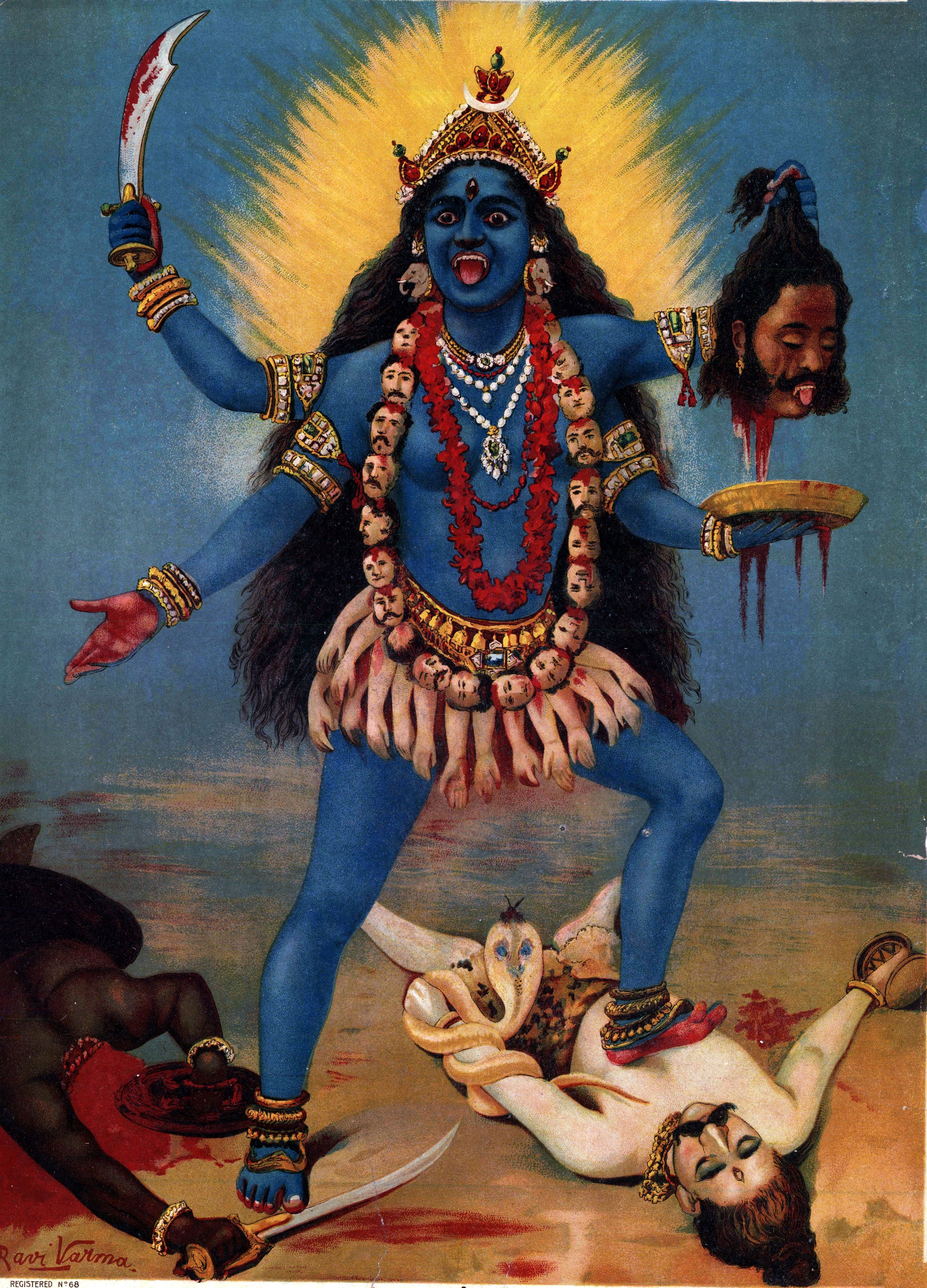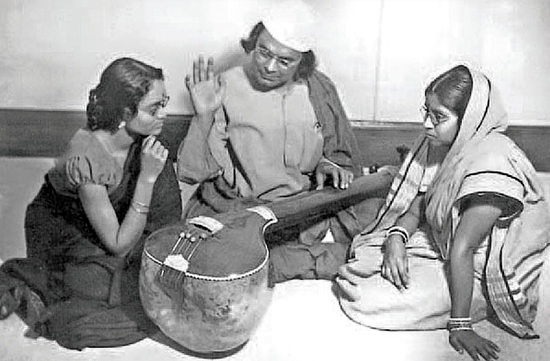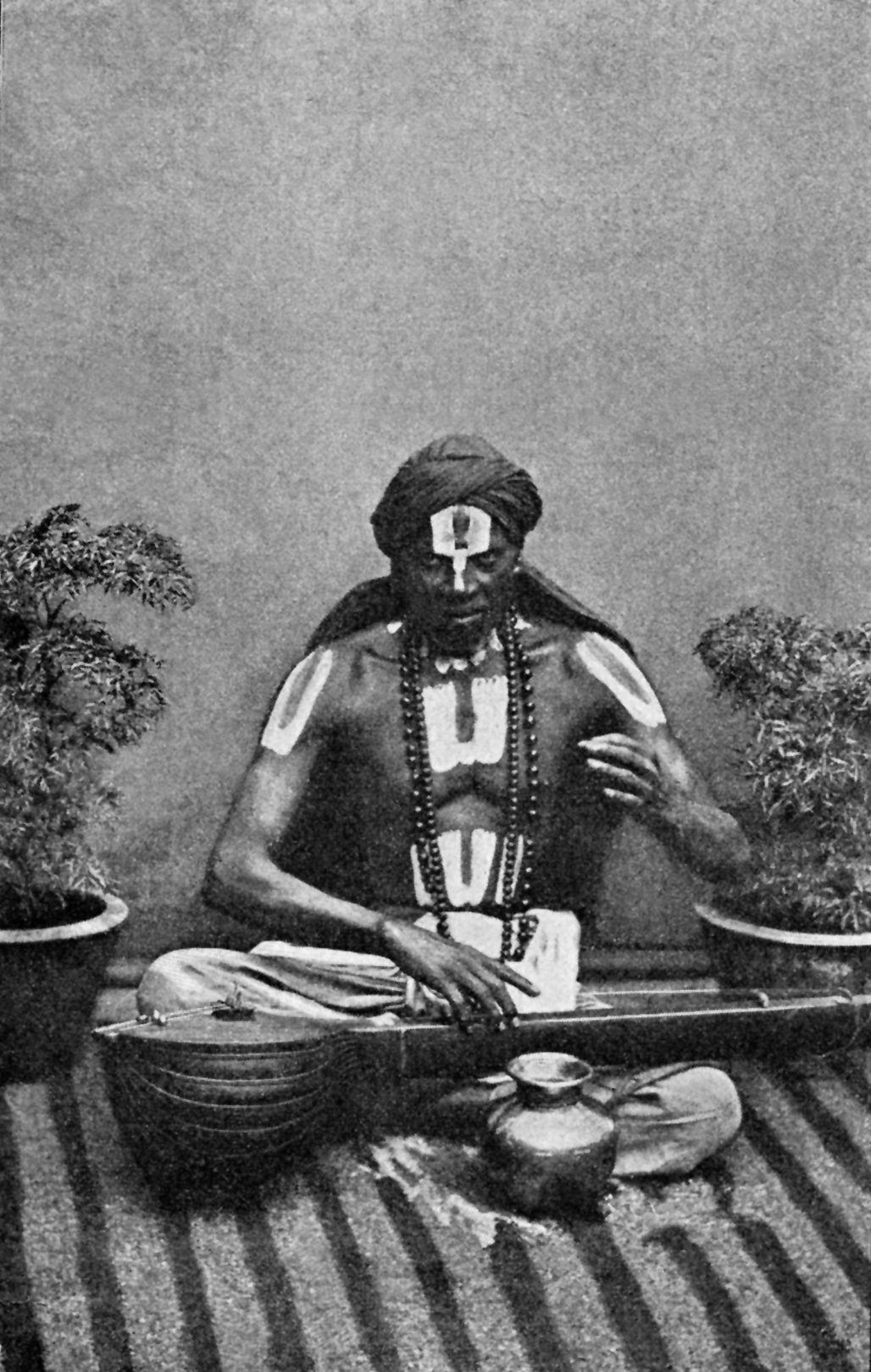|
Shyama Sangeet
Shyama Sangeet ( bn, শ্যামা সঙ্গীত ) is a genre of Bengali devotional songs dedicated to the Hindu goddess Shyama or Kali which is a form of supreme universal mother-goddess Durga or parvati. It is also known as Shaktagiti or Durgastuti. Shyama Sangeet appeals to the common man because it is a musical representation of the relationship of eternal and sublime love and care between the mother and her child. It is free of the common rituals of worship and also the esoteric practice of the Tantra. Origin During the 12th-13th centuries when Shaktism grew in Bengal, it inspired a number of poets to compose poems on Kali. Mukundarāma, known as Kavikaṅkaṇ or 'gem of poets, ' wrote his chief poem, the epic Chaṇḍī, in 1589. Towards the middle of the 18th century, the poet Ramprasad Sen instilled new life into it and turned it into a distinct genre of Bengali songs. Ramprasad was succeeded by number of composers like Kamlakanta Bhattacharya (1772–1821), ... [...More Info...] [...Related Items...] OR: [Wikipedia] [Google] [Baidu] |
Bengali Language
Bengali ( ), generally known by its endonym Bangla (, ), is an Indo-Aryan language native to the Bengal region of South Asia. It is the official, national, and most widely spoken language of Bangladesh and the second most widely spoken of the 22 scheduled languages of India. With approximately 300 million native speakers and another 37 million as second language speakers, Bengali is the fifth most-spoken native language and the seventh most spoken language by total number of speakers in the world. Bengali is the fifth most spoken Indo-European language. Bengali is the official and national language of Bangladesh, with 98% of Bangladeshis using Bengali as their first language. Within India, Bengali is the official language of the states of West Bengal, Tripura and the Barak Valley region of the state of Assam. It is also a second official language of the Indian state of Jharkhand since September 2011. It is the most widely spoken language in the Andaman and Nic ... [...More Info...] [...Related Items...] OR: [Wikipedia] [Google] [Baidu] |
Kali
Kali (; sa, काली, ), also referred to as Mahakali, Bhadrakali, and Kalika ( sa, कालिका), is a Hindu goddess who is considered to be the goddess of ultimate power, time, destruction and change in Shaktism. In this tradition, she is considered as a ferocious form of goddess Mahadevi, the supreme of all powers, or the ultimate reality. She is the first of the ten Mahavidyas in the Hindu tantric tradition. Kali's earliest appearance is when she emerged from Shiva. She is regarded as the ultimate manifestation of Shakti, and the mother of all living beings. The goddess is stated to destroy evil in order to protect the innocent. Over time, Kali has been worshipped by devotional movements and Tàntric sects variously as the Divine Mother, Mother of the Universe, Principal energy Adi Shakti. Shakta Hindu and Tantric sects additionally worship her as the ultimate reality or ''Brahman''. She is also seen as the divine protector and the one who bestows ''m ... [...More Info...] [...Related Items...] OR: [Wikipedia] [Google] [Baidu] |
Tantra
Tantra (; sa, तन्त्र, lit=loom, weave, warp) are the esoteric traditions of Hinduism and Buddhism that developed on the Indian subcontinent from the middle of the 1st millennium CE onwards. The term ''tantra'', in the Indian traditions, also means any systematic broadly applicable "text, theory, system, method, instrument, technique or practice". A key feature of these traditions is the use of mantras, and thus they are commonly referred to as Mantramārga ("Path of Mantra") in Hinduism or Mantrayāna ("Mantra Vehicle") and Guhyamantra ("Secret Mantra") in Buddhism. Starting in the early centuries of the common era, newly revealed Tantras centering on Vishnu, Shiva or Shakti emerged. There are tantric lineages in all main forms of modern Hinduism, such as the Shaiva Siddhanta tradition, the Shakta sect of Sri-Vidya, the Kaula, and Kashmir Shaivism. In Buddhism, the Vajrayana traditions are known for tantric ideas and practices, which are based on Ind ... [...More Info...] [...Related Items...] OR: [Wikipedia] [Google] [Baidu] |
Shaktism
Shaktism ( sa, शाक्त, , ) is one of several major Hindu denominations, wherein the metaphysical reality is considered metaphorically a woman and Shakti (Mahadevi) is regarded as the supreme godhead. It includes many goddesses, all considered aspects of the same supreme goddess. Shaktism has different sub-traditions, ranging from those focused on most worshipped Durga, gracious Parvati to that of fierce Kali. The Sruti and Smriti texts of Hinduism are an important historical framework of the Shaktism tradition. In addition, it reveres the texts ''Devi Mahatmya'', the '' Devi-Bhagavata Purana'', '' Kalika Purana'' and Shakta Upanishads such as the Devi Upanishad. The ''Devi Mahatmya'' in particular, is considered in Shaktism to be as important as the ''Bhagavad Gita''. Shaktism is known for its various sub-traditions of tantra, as well as a galaxy of goddesses with respective systems. It consists of the Vidyapitha and Kulamārga. The pantheon of goddesses in ... [...More Info...] [...Related Items...] OR: [Wikipedia] [Google] [Baidu] |
Ramprasad Sen
( bn, রামপ্রসাদ সেন; c. 1718 or c. 1723 – c. 1775) was a Hindu Shakta poet and saint of eighteenth century Bengal. His ''bhakti'' poems, known as Ramprasadi, are still popular in Bengal—they are usually addressed to the Hindu goddess Kali and written in Bengali., p. 162 Stories of Ramprasad's life typically include legends and myths mixed with biographical details. It is said that, Ramprasad was born into a Bengali Baidya family, and showed an inclination towards poetry from an early age. He was highly influenced by Krishnananda Agamavagisha, a Tantric scholar and yogi. Ramprasad became well known for his devotional songs. His life has been the subject of many stories depicting his devotion to, and relationship with, Kali. Ramprasad's literary works include ''Vidyasundar'', ''Kali-kirtana'', ''Krishna-kirtana'' and ''Shaktigiti''. Ramprasad is credited with creating a new compositional form that combined the Bengali folk style of Bau ... [...More Info...] [...Related Items...] OR: [Wikipedia] [Google] [Baidu] |
Rabindranath Tagore
Rabindranath Tagore (; bn, রবীন্দ্রনাথ ঠাকুর; 7 May 1861 – 7 August 1941) was a Bengali polymath who worked as a poet, writer, playwright, composer, philosopher, social reformer and painter. He reshaped Bengali literature and music as well as Indian art with Contextual Modernism in the late 19th and early 20th centuries. Author of the "profoundly sensitive, fresh and beautiful" poetry of '' Gitanjali'', he became in 1913 the first non-European and the first lyricist to win the Nobel Prize in Literature. Tagore's poetic songs were viewed as spiritual and mercurial; however, his "elegant prose and magical poetry" remain largely unknown outside Bengal. He was a fellow of the Royal Asiatic Society. Referred to as "the Bard of Bengal", Tagore was known by sobriquets: Gurudev, Kobiguru, Biswakobi. A Bengali Brahmin from Calcutta with ancestral gentry roots in Burdwan district* * * and Jessore, Tagore wrote poetry as an eight-ye ... [...More Info...] [...Related Items...] OR: [Wikipedia] [Google] [Baidu] |
Kazi Nazrul Islam
, pseudonym = bn, ধূমকেতু, Dhūmketu , image = Nazrul.jpg , image_size = , caption = Nazrul in Chittagong, 1926 , birth_date = 11 ''Joiṣṭhyô'', 1306 '' Bônggabdô'' , birth_place = Churulia, Asansol, Bengal Presidency, British India , death_date = , death_place = Dhaka, Bangladesh , resting_place = Mausoleum of Kazi Nazrul Islam , occupation = , language = , citizenship = British Indian Indian Bangladeshi , education = , alma_mater = , period = 1922–1942 , genre = , subject = , movement = Bengali Renaissance , notableworks = , spouse = , children = , awards = , signature = Signature of Kazi Nazrul.jpg , signature_alt = , module = , party = Worke ... [...More Info...] [...Related Items...] OR: [Wikipedia] [Google] [Baidu] |
Durga
Durga ( sa, दुर्गा, ) is a major Hindu goddess, worshipped as a principal aspect of the mother goddess Mahadevi. She is associated with protection, strength, motherhood, destruction, and wars. Durga's legend centres around combating evils and demonic forces that threaten peace, prosperity, and dharma, representing the power of good over evil. Durga is believed to unleash her divine wrath against the wicked for the liberation of the oppressed, and entails destruction to empower creation. Durga is seen as a motherly figure and often depicted as a beautiful woman, riding a lion or tiger, with many arms each carrying a weapon and often defeating demons. She is widely worshipped by the followers of the goddess-centric sect, Shaktism, and has importance in other denominations like Shaivism and Vaishnavism. The most important texts of Shaktism, Devi Mahatmya, and Devi Bhagavata Purana, revere Devi (the Goddess) as the primordial creator of the universe and the Bra ... [...More Info...] [...Related Items...] OR: [Wikipedia] [Google] [Baidu] |
Amar Sonar Bangla
"" ( bn, আমার সোনার বাংলা, lit=My Golden Bengal, ) is the national anthem of Bangladesh. An ode to Mother Bengal, the lyrics were written by Bengali polymath Rabindranath Tagore in 1905, while the melody of the hymn was adopted from the Baul singer Gagan Harkara's song "Ami Kothay Pabo Tare" () set to Dadra Tala. The modern instrumental rendition was arranged by Bangladeshi musician Samar Das. Etymology The word literally means "made of gold", with meaning gold, and showing possession. It is used as a term of endearment meaning "beloved", but in the song the words may be interpreted to express the preciousness of Bengal. History The song was written in 1905 during the first partition of Bengal, when the ruling British Empire had an undivided province of Bengal Presidency split into two parts; the decision was announced on 20 July by the then-Viceroy of India Lord Curzon, taking effect on 16 October. This divide of Bengal, being along com ... [...More Info...] [...Related Items...] OR: [Wikipedia] [Google] [Baidu] |
Bengali Culture
The culture of Bengal defines the cultural heritage of the Bengali people native to eastern regions of the Indian subcontinent, mainly what is today Bangladesh and the Indian states of West Bengal and Tripura, where the Bengali language is the official and primary language. Bengal has a recorded history of 1,400 years. The Bengali people are its dominant ethnolinguistic group. The region has been a historical melting point, blending indigenous traditions with cosmopolitan influences from pan-Indian subcontinental empires. Bengal was considered to be the richest part of Islamic medieval India and during the era of the Bengal Sultanate it was described to be a major trading nation in the world, while during Mughal times, having triggered the proto-industrialization, its economy was worth 12% of global GDP. However, significant socio-economic inequalities existed during this period. As a part of the Bengal Presidency, it also hosted the region's most advanced political and cul ... [...More Info...] [...Related Items...] OR: [Wikipedia] [Google] [Baidu] |
Bengali Music
Bengali music ( bn, বাংলা সংগীত) comprises a long tradition of religious and secular song-writing over a period of almost a millennium. Composed with lyrics in the Bengali language, Bengali music spans a wide variety of styles. The Bengal region of the Indian subcontinent is currently split between the Indian state of West Bengal and the country of Bangladesh. West Bengal is still referred to as Bengal in the rest of India. History The earliest music in Bengal was influenced by Sanskrit chants, and evolved under the influence of Vaishnav poetry such as the 13th-century ''Gitagovindam'' by Jayadeva, whose work continues to be sung in many eastern Hindu temples. The Middle Ages saw a mixture of Hindu and Islamic trends when the musical tradition was formalized under the patronage of Sultan and Nawabs and the powerful landlords ''baro bhuiyans''. Much of the early canon is devotional, as in the Hindu devotional songs of Ramprasad Sen a bhakta who c ... [...More Info...] [...Related Items...] OR: [Wikipedia] [Google] [Baidu] |
Hindu Music
Hindu music is music created for or influenced by Hinduism. It includes Indian classical music, Kirtan, Bhajan and other musical genres. Raagas are a common form of Hindu music in classical India. The most common Hindu bhajan in North India is " Om Jai Jagdish Hare." The names of Gods are religiously chanted, often including Vishnu and his incarnations, Shiva and the Goddess (Parvati, Shakti, Vaishnodevi). A very common scale in Hindu music is 1 2 3 4 5 6 7, which can be harmonized into a chord progression. ''Bhajan'' A bhajan is a Hindu devotional song, often of ancient origin. Bhajans are often simple songs in lyrical language expressing emotions of love for the Divine, whether for a single God and Goddess, or any number of divinities. Many bhajans feature several names and aspects of the chosen deity, especially in the case of Hindu sahasranamas, which list a divinity's 1008 names. Great importance is attributed to the singing of bhajans with Bhakti, i.e. loving devot ... [...More Info...] [...Related Items...] OR: [Wikipedia] [Google] [Baidu] |










